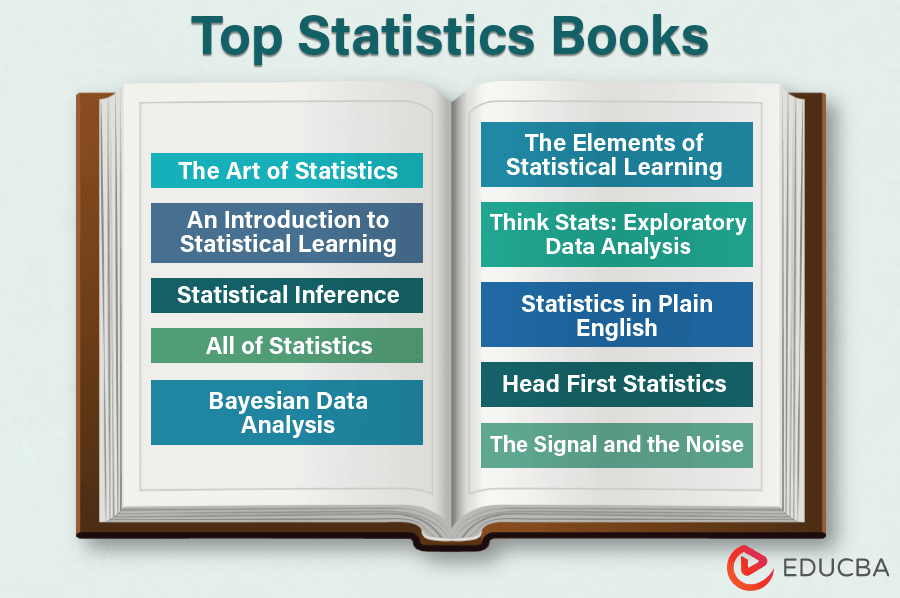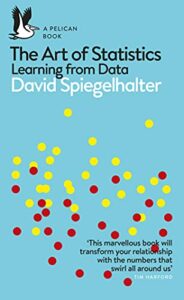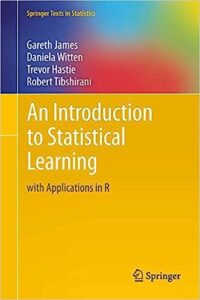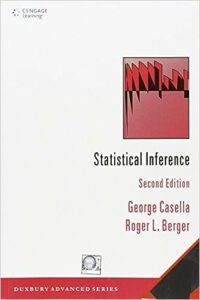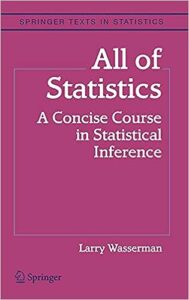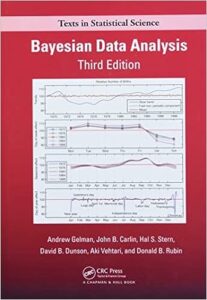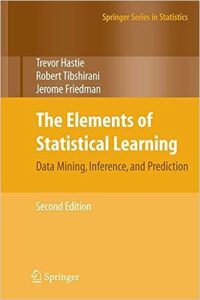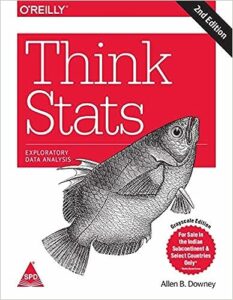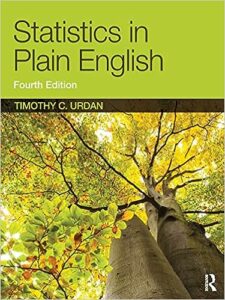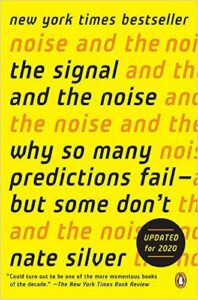Top Statistics Books – Introduction
Statistics books guide readers to scientifically collect, analyze, interpret, and present observed data appropriately. Statistics plays a role in an individual’s life as it helps in decision-making and financial planning. For instance, analysts use statistics to understand the financial market and future economic crises. The list of books we have provided below will give the readers a clear understanding of statistics. These reads will guide you in selecting the right one for your requirement to increase your knowledge or make strides in your work.
Here is a list of the top 10 statistics books for you.
| # | Book | Author | Original Publishing Date | Rating |
| 1. | The Art of Statistics: Learning from Data | David Spiegelhalte | 2019 | Amazon: 4.5 Goodreads: 4.17 |
| 2. | An Introduction to Statistical Learning | Gareth James, Daniela Witten, Trevor Hastie, and Robert Tibshirani | 2013 | Amazon: 4.7
Goodreads: 4.59 |
| 3. | Statistical Inference | George Casella and Roger L. Berger | 1990 | Amazon: 4.5
Goodreads: 4.15 |
| 4. | All of Statistics: A Concise Course in Statistical Inference | Larry Wasserman | 2004 | Amazon: 4.4
Goodreads: 4.23 |
| 5. | Bayesian Data Analysis | Andrew Gelman, John B. Carlin, Hal S. Stern, David B. Dunson, Aki Vehtari, and Donald B. Rubin | 1995 | Amazon: 4.7
Goodreads: 4.22 |
| 6. | The Elements of Statistical Learning: Data Mining, Inference, and Prediction | Trevor Hastie, Robert Tibshirani, and Jerome Friedman | 2001 | Amazon: 4.7
Goodreads: 4.42 |
| 7. | Think Stats: Exploratory Data Analysis | Allen B. Downey | 2011 | Amazon: 4
Goodreads: 3.62 |
| 8. | Statistics in Plain English | Timothy C. Urdan | 2001 | Amazon: 4.6
Goodreads: 3.89 |
| 9. | Head First Statistics: A Brain-Friendly Guide | Dawn Griffiths | 2008 | Amazon: 3.9
Goodreads: 3.93 |
| 10. | The Signal and the Noise: Why So Many Predictions Fail—But Some Don’t | Nate Silver | 2012 | Amazon: 4.4
Goodreads: 3.97 |
Let us now go through each book to see what it offers to help select the best statistics books for you.
Book #1: The Art of Statistics: Learning from Data
Authors: David Spiegelhalte
Get this book here.
Review:
This book is a comprehensive guide to statistical analysis by renowned statistician David Spiegelhalter. The book covers a variety of statistical concepts and methods, from fundamental statistical thinking to more advanced concepts like Bayesian statistics. The main strengths of this book include its accessibility, practical approach to statistics, and the section on probability.
Key Points:
- The book is accessible and avoids using complex jargon, making it suitable for readers with no background in statistics.
- The book emphasizes the practical application of statistics and provides numerous examples from different fields.
- The section on probability is applaudable and well-written and provides a clear explanation of the different types of probability and their application.
Book #2: An Introduction to Statistical Learning: With Applications in R
Authors: Gareth James, Daniela Witten, Trevor Hastie, and Robert Tibshirani
Get this book here.
Review:
This book is an excellent resource for anyone interested in statistical modeling. It emphasizes the importance of understanding the underlying theory behind statistical models and provides practical guidance on applying these models to real-world problems.
Key Points:
- The book covers statistical modeling techniques and provides numerous examples and exercises to reinforce learning.
- It emphasizes practical applications using the R programming language, allowing readers to apply statistical methods to real-world data.
- Whether you’re a student, data scientist, or professional, this book is an ideal resource for self-study and building a strong foundation in statistical and machine learning.
Book #3: Statistical Inference
Authors: George Casella and Roger L. Berger
Get this book here.
Review:
The book “Statistical Inference” by George Casella and Roger L. Berger is a classic guide to statistical analysis. It covers key topics like making estimates, testing hypotheses, and understanding data relationships. The authors explain these concepts clearly and provide plenty of examples and exercises to help you learn and practice.
Key Points:
- The book includes techniques for estimating population parameters, such as means and proportions, using sample data.
- It is suitable for advanced undergraduate and graduate-level courses, researchers, and practitioners in the field.
- The authors provide numerous examples and exercises to reinforce learning.
Book #4: All of Statistics: A Concise Course in Statistical Inference
Author: Larry Wasserman
Get the book here.
Review:
This book by Larry Wasserman is an excellent resource, providing a clear introduction to essential statistical concepts and methods. The author’s emphasis on understanding concepts rather than memorizing formulas makes the book accessible to readers with varying levels of mathematical background. The book is well-structured and contains numerous examples and exercises to reinforce key concepts.
Key Points:
- It covers essential statistical concepts and methods, including probability theory, hypothesis testing, regression analysis, and Bayesian inference.
- Despite its comprehensiveness, the book uses concise explanations, making complex concepts easier for a broader audience, including beginners.
- It includes theory and practical application, offering both the underlying mathematical foundations and real-world examples to illustrate the concepts.
Book #5: Bayesian Data Analysis
Authors: Andrew Gelman, John B. Carlin, Hal S. Stern, David B. Dunson, Aki Vehtari, and Donald B. Rubin
Get the book here.
Review:
This is an authoritative and comprehensive introduction guide to Bayesian statistics. The book covers essential topics using clear explanations and practical examples. It also includes numerous exercises and datasets to reinforce the key concepts. It is a must-read for anyone looking to improve their skills in Bayesian statistics.
Key Points:
- The book covers fundamental Bayesian concepts such as prior distributions, likelihood functions, and posterior distributions, laying the groundwork for understanding Bayesian data analysis.
- It also provides practical guidance on computational tools and software, like WinBUGS and Stan.
- The author explores Bayesian techniques for modeling complex data structures, including hierarchical models, time series analysis, and multilevel modeling.
Book #6: The Elements of Statistical Learning: Data Mining, Inference, and Prediction
Authors: Trevor Hastie, Robert Tibshirani, and Jerome Friedman
Get the book here.
Review:
This book is a comprehensive guide to machine learning and statistical modeling. It covers essential topics such as linear regression, tree-based methods, support vector machines, and neural networks. The authors provide clear explanations and practical examples to help readers understand the material. The book also includes plenty of exercises and datasets to reinforce the key concepts.
Key Points:
- The author introduces readers to the tools and algorithms commonly used in data analysis and machine learning.
- It provides real-life examples and case studies showing how statistical learning helps solve actual problems in various fields.
- The book is a must-have and relevant in today’s data-driven world.
Book #7: Think Stats: Exploratory Data Analysis
Author: Allen B. Downey
Get the book here.
Review:
The book enables programming and converting data into valuable statistical information and probability. The author has simplified the steps in exploratory data analysis using a single case study. Moreover, the book shows the process of collecting and using that data for statistics to enable pattern identification and testing theories. The readers also learn to compute programs in Python.
Key Points:
- The book teaches the reader to write codes for statistics and probability and tests them.
- The reader makes inferences from statistical behavior about the real world.
- The book enables the learner to Import data using Python from sources rather than depending on ready-made data.
Book #8: Statistics in Plain English
Author: Timothy C. Urdan
Get this book here.
Review:
This book gives readers an insight into how statistics function and how to decipher them correctly. The author starts with the fundamentals of statistics and learns advanced concepts like t-tests, repeated measures, etc. Further, each chapter illustrates the statistics in chapter discussion with an example and how to write for a publication, educating the learner with the concept and formal presentation.
Key Points:
- The reader gets questions with solutions at the end of each chapter to test and increase their understanding.
- The author has added case-study examples from journals to help the reader understand the professional world application.
- The book includes advanced topics like regression, ANOVA, and factor analysis.
- It contains a quick reference guide in the beginning to help the reader comprehend various types of statistics, formulae, and their usage.
Book #9: Head First Statistics
Author: Dawn Griffiths
Get this book here.
Review:
The author makes learning statistics exciting and interactive. The book begins with basic concepts and covers histograms and chi-square analysis. It also includes puzzles, quizzes, and real-life stories to engage readers. The book suits beginners, advanced learners, and professors looking to enhance their teaching. High school students and undergraduates will also find it helpful.
Key Points:
- The book covers real-life scenarios, teaching the learners to calculate favorable and unfavorable situations through probability.
- The author also explores regression analysis and different probability distributions.
- The book uses an engaging and interactive approach to make statistics enjoyable and easier to learn.
Book #10: The Signal and the Noise: Why So Many Predictions Fail—But Some Don’t
Author: Nate Silver
Get this book here.
Review:
Nate Silver, Editor-in-Chief of FiveThirtyEight.com, has a knack for making accurate predictions, like in baseball and the 2008 and 2012 elections. His book teaches how to make better guesses from lots of data. He emphasizes that people often mess up because they don’t grasp uncertainty and probability well, which can harm society.
Key Points:
- The author explains how to get the truth from data in real-life scenarios like hurricanes, poker tables, the stock market, or the NBA.
- The reader understands the best predictors by developing the right mindset to make predictions from data.
- The author enables the reader to adopt the two most required qualities, being humble and hardworking.
Recommended Books
We created this article about the top 10 statistics books to assist you in picking the right book for your requirements. For more information, EDUCBA suggests checking out these articles.
